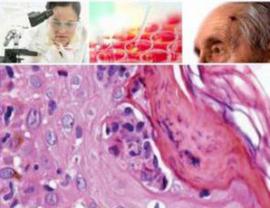Skin - the largest by area organ in the body human. Skin tumors such as melanoma, are highly malignant. Propensity to melanomas and a massed early metastasis is a cause of fatal consequences of untimely or poor quality diagnostics of the disease.
Non-neoplastic pathology include skin diseases caused by fungal and bacterial infections, photodermatitis, psychogenic, hereditary, metabolic, endocrine dermatitis, skin diseases associated with abnormal immune system and pathology of connective tissue, diseases of skin appendages - hair and nails.
All this is a widespread pathology from which the patient suffers, degrades the quality of life. The attending physician In this case remains in private with the clinical picture, which in many skin diseases have common features, that excludes an opportunity understand the nature of of the disease and, therefore, to appoint the right effective treatment.
This explains the need for the appointment of histological diagnosis in various diseases of the skin.
For its holding there is a wide range of surgical instruments that allow accurate and minimally traumatic to obtain the necessary samples of skin.
Pathological skin disease
The pathological condition of the skin in some diseases appear on previously intact skin, and sometimes the result of the evolution of certain elements of skin rashes. The pathological conditions of the skin include:
- Keratosis - layering of dense dry horny mass of grayish-yellow color. Usually it occurs on the skin of the palms and soles (calluses, keratoderma). Secondary keratosis occurs in existing inflammatory changes in the skin (psoriasis).
- Vegetation - occurs result in hypertrophy malpighian layer of the epidermis and dermal papilla in a long field of inflammation. On the skin surface are formed a papillary thickening in the form of villi or fingerlike outgrowths. Vegetation is covered with hypertrophied horny layer or, on the contrary, it is deprived its. In the first case, they look like grayish-yellowish scaly warts. With the localization of vegetation in the crotch area, they have a kind of juicy, soft, hyperemic growths.
- Lichenification - a condition resulting from constant scratching of the skin, due to which it becomes stiff and thickened. It can arise secondary to many dermatoses, accompanied by itching or develop in the form of local pathology without of predisposing diseases, the so-called simple lichen, or primary Lichenification. The main symptom is itching, which can be very pronounced with minimal skin manifestations.
- Anetoderma - a type of focal primary atrophy of the skin. Meets seldom, mostly in young and middle-aged. The etiology is not known. In some cases, found an association with chronic infection (tuberculosis, leprosy). Are sometimes observed positive results of treatment with penicillin, which confirms the theory of infectious diseases. Предполагается влияние нейроэндокринных нарушений. There are erythematous, urticaria (anetoderma Jadassohn - Pellitstsari) and pseudotumor (anetoderma Shveningera - Butsii) anetoderma form.
- Dermatosclerosis - limited or diffuse thickening of the skin with loss of its elasticity. Dermatosclerosis can be congenital malformation of the skin, acquired - the primary symptom of the disease (such as scleroderma) and a secondary symptom, a consequence of lymphatic or hemostasis (most often in the lower limbs). Dermatosclerosis develops as a result of destruction of the elastic and hypertrophy of collagen fiber. Pathological process can capture and subcutaneous tissue and underlying tissues.
- Atrophoderma - a disease associated with eating disorders of the skin. Due to the scarcity of nutrients decreases the volume of all the elements of the skin or its individual layers. Atrophoderma more common in women. One of the causes of eating disorders of the skin may become the appearance of stretch marks during pregnancy sions or sudden weight gain. Another common reason for the appearance areas of atrophoderma are the processes aging of the skin, this form of the disease common in older patients.
hide
 Dermatopathology specializes in various pathologies of the skin. In the field of Dermatopathology works as pathologists and dermatologists.
Dermatopathology specializes in various pathologies of the skin. In the field of Dermatopathology works as pathologists and dermatologists. 






